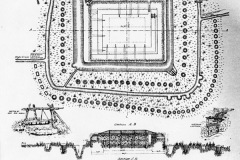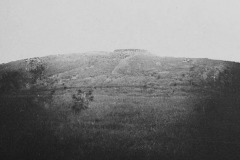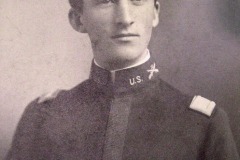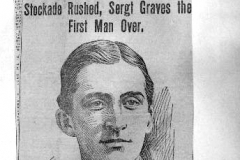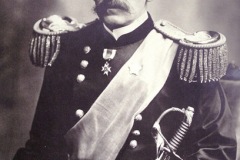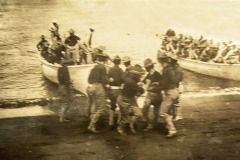Historic Operations: The Philippines
The Battle of Bayan, May 2, 1902

The Battle of Bayan was the first hostile encounter between Moros and the US Army. It took place at the south end of Lake Lanao on the island of Mindanao. It was the result of a punitive expedition launched by the newly-arrived, second-ranking officer for the Military District of Mindanao and Sulu, Colonel Frank D. Baldwin, also commanding officer of the 27th Infantry Regiment and two troops of the 15th Cavalry. It was precipitated by two murders, three weeks apart, of enlisted soldiers of the 27th who had strayed outside their camp at Malabang on the island of Mindanao, both set upon and killed for their Krag rifles. Baldwin took his entire command of 1,025 men on the expedition and added the 25th Battery of the Field Artillery (65 men), ten six-mule teams and 40 pack mules run by contract civilian packers, and 300 hired Maguindanao cargadores. 600 men of the 10th and 17th Infantry Regiments were moved to Malabang as temporary replacements for his forces and to serve as a reserve.
The battle was lauded by the American press and the Roosevelt Administration as a signal victory, the resisting Maranaos described as having been "thoroughly whipped" and taught a "salutary lesson" after losing between 300-400 killed versus eleven killed and forty severely wounded for the Americans. But Baldwin's immediate superior, Brigadier General George W. Davis, and the commanding officer of the Philippine Department, Major General Adna Chaffee, were greatly upset and angered by Baldwin's conduct; believing he had acted impetuously, with insubordination, and ineptly, which could have easily ended in a major disaster. Behind the scenes President Roosevelt was furious with General Chaffee for having apparently allowed an entirely new front to open up just as he was about to proclaim the Philippine Islands were finally pacified and peaceful after a grinding, 3 1/2 year long, less than popular war. In addition it undercut a slower yet progressively more successful attempt initiated by Davis to negotiate a peaceful solution through the efforts of Captain John J. Pershing. In fact Chaffee believed that had it not been for Pershing's last minute success in convincing the most powerful datus at the north end of the lake not to join in the defense of Bayan, Baldwin's expedition might have been a disaster. This prompted Chaffee towards an exceptional decision; to see to it that Baldwin was promoted up and out of Moroland and to turn over the Lanao mission to this same unknown junior officer.
The 27th Infantry was one of ten new Regular Army regiments authorized for the Philippine-American War. It was organized February 2, 1901. However, its official birthday is recognized on May 2, the date of its baptism by fire at the Battle of Bayan. Its first Regimental crest (shown above), used until 1922, reflects that heritage. Colonel Frank Baldwin, its first commanding officer, was unique in Army history, a rare two-time winner of the Medal of Honor, first in 1864 during the Civil War and then in 1877 against the Cheyenne. In April of 1902 it replaced the 23rd Infantry in Moroland and established its headquarters next to an old Spanish fort at Malabang, a settlement on the island of Mindanao on the shores of the Moro Gulf north of Cotabato.
By the time the expedition arrived at Bayan, it was down to about 600 effective rifles and the pack mules had been doubled to 80 to help make up for the loss of the Maguindanao cargadores. Baldwin's objective was the capture of two prominent cottas, or forts about a thousand yards apart on a high ridge overlooking Lake Lanao, at an altitude of about 2,900 feet. The first, and highest was Binadayan, the redoubt of the Sultan of Bayan who had signaled in writing his intent to resist the Americans. Men with rifles could be clearly seen on the walls of Binadayan by a reconnaissance party, and a red flag, the sign of war, was flying at its staff. An ultimatum was given to surrender the fort before 12:00 noon the next day. Binadayan was taken fairly quickly after about a one-hour fight, with only one American wounded and a small number of Moros killed. Apparently prior to the assault the Sultan and most of his men moved across the small valley to the second, larger cotta, Pandapatan, that of the Sultan of Pandapatan, who was the war leader of the defense. About 600 Maranao warriors, including about 150 sent by other datus, made their stand at Pandapatan. Lacking in scaling ladders, running low on ammunition, and coming under a fierce, hand-to-hand counterattack outside the walls, the Americans the assault when dark came, accompanied by lightning, heavy fog, and a deluge of rain. They spent the rest of a miserable night slowly withdrawing to Binadayan, with members of the 25th Field Artillery courageously crawling out on the field to retrieve the wounded and dead. But the next morning, a white flag of surrender flew from Pandapatan.
22 year-old 1st Lt. Hugh Drum was the adjutant for the 2nd Battalion. His was an unusual route into the Army. He was direct-commissioned as a 2nd Lt. at age 19 while attending Boston College under an unusual provision of the law. His father, a Captain, was killed at San Juan Hill in Cuba in 1898 and a special bill permitted the President to make such appointments. He was on the field at Bayan and at one point helped another man hoist a soldier onto their shoulders to fire over a parapet. Despite the contention of his home town newspaper that he practically "led the charge", he was not mentioned in orders nor in the after-battle report. Bayan would be the only fighting he would see in Moroland. Politically savvy, Drum rose in the Army and in World War I, as a Colonel, became Pershing's Chief of Staff for the AEF. But on the eve of World War II, although next in line through seniority, he was passed over for Chief of Staff by Franklin Roosevelt in favor of George Marshall. Fort Drum, New York was named in his honor.
Ever hear of Laguna de Lanao
In the sunny southern Isle of Mindanao?
Where the Twenty-Seventh went with Baldwin
Peacefully intent and called on
All the Dattos up at Lake Lanao– opening stanza of the Regimental Song
For more details on this historic battle, see Battle of Bayan on Wikipedia





